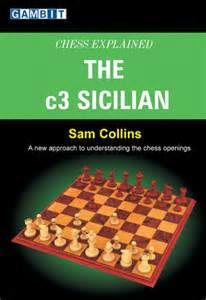Chess Explained — The c3 Sicilian
Sam Collins

The CHESS EXPLAINED series is, according to the back-cover blurb, a new series of books about chess openings. They are not theoretical works in the traditional sense, but more a series of lessons from a chess expert with extensive over-the-board experience with an opening. You will gain an understanding of the opening and the middlegames to which it leads, enabling you to find the right moves and plans in your own games. It is as if you were sitting at the board with a chess coach answering your questions about the plans for both sides, the ideas behind particular moves, and what specific knowledge you need to have.
Previous books in this series are CHESS EXPLAINED: THE QUEENS INDIAN by Peter Wells, CHESS EXPLAINED: THE CLASSICAL SICILIAN by Alex Yermolinsky, CHESS EXPLAINED: THE TAIMANOV SICILIAN by James Rizzitano, CHESS EXPLAINED: THE ENGLISH OPENING by Zenon Franco.
Thus far, all have been excellent, with our reviewer John Donaldson giving hearty thumbs up for each and every one.
Now we come to CHESS EXPLAINED: THE c3 SICILIAN. Ive long felt that 1.e4 players who enter main line Sicilians are at an odd sort of disadvantage since they must know how to deal with all of Blacks Sicilian systems while Black only needs to know one. The work involved in being able to stay on top of such an enormous amount of opening information is daunting, and so I usually recommend potent anti-Sicilian sidelines like 1.e4 c5 2.Nf3 Nc6 3.Bb5 or 1.e4 c5 2.c3. During my 1.e4 youth I used both to good effect and, nowadays, strong grandmasters regularly trot them out.
When this review first came out, The Bible of 2.c3 was PLAY THE 2.c3 SICILIAN by Rozentalis and Harley. Since then, the new Bible is Sveshnikovs THE COMPLETE c3 SICILIAN. However the Rozentalis/Harley book came out in 2002, while Sveshnikovs book is huge and advanced. To me, this means that something more up to date is needed, yet that something should also be amateur friendly. Collins CHESS EXPLAINED: THE c3 SICILIAN fits the bill due to his introductory comments and his detailed explanations of both sides ideas and plans. Here’s something I deemed quite interesting from the introduction:
Some, like Tiviakov, maintain that the c3 Sicilian gives better chances of an advantage than the Open Sicilian. This argument needs to be broken down a little:
a) On an objective basic (i.e. assuming best play from both sides), the c3 Sicilian doesnt give White more chances of an advantage than an Open Sicilian. Sorry.
b) On a subjective basis, I think the c3 Sicilian gives some extra chances of an edge, since Sicilian players inevitably devote more time and effort to learning the lines after 2.Nf3 and 3.d4, so they often dont know the best responses to the c3 lines.
Sam Collins honesty is commendable, and instantly lets us know that this book offers a fair look at both sides chances.
I especially like it when Collins discusses basic structures and strategic ideas. Heres one example (after the moves 1.e4 c5 2.c3 Nf6 3.e5 Nd5 4.d4 cxd4 5.Nf3 e6 6.cxd4 d6 7.Bc4 Nb6 8.Bb3 dxe5 9.Nxe5 Nc6! 10.Nxc6 bxc6):
Its natural to think that the forthcoming isolated pawn on c6 is a weakness, but this is only partly true. In fact, its quite difficult to create genuine pressure on this pawn, while it gives Black three major pluses:
1) The prospect of play down the half-open b-file;
2) Total restraint of the d-pawn;
3) He has the option of playing …c5 and eliminating the last white center pawn.
Strategic discussions like this (many being far more detailed) are littered throughout this book!
I recommend CHESS EXPLAINED: THE c3 SICILIAN for players in the 1300 to 2000 range.
